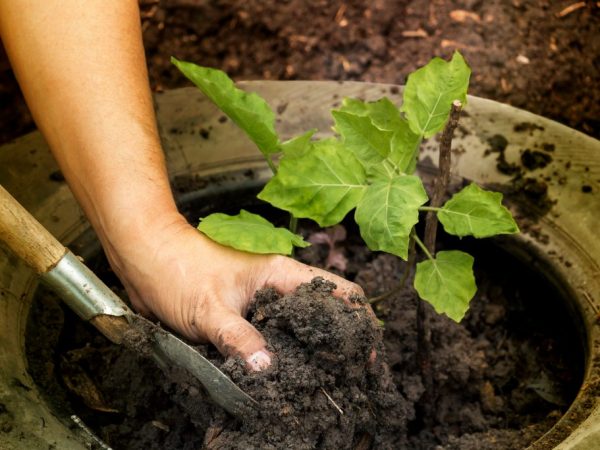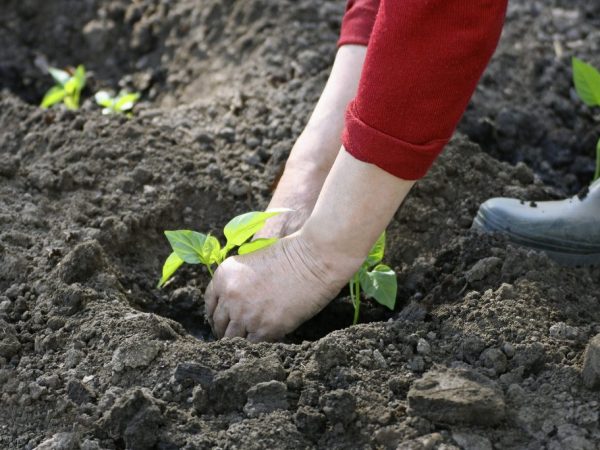Features of planting eggplants in open ground
In order for eggplant seedlings in the open field to feel good, the plants are provided with warmth. The garden bed is prepared in advance using fertilizers. When grown in poor soil, the bushes will not please with a high yield.

Features of planting eggplants in open ground
Disembarkation dates
Early varieties are most suitable for growing eggplant outdoors. When the seedlings reach a height of 15-20 cm and 5-7 true leaves appear on them, the plants are ready for planting. Seedlings should be between 60 and 90 days old, depending on the variety and when the seeds are sown. Sometimes buds are already formed on it.
Planting eggplants in open ground is carried out at a soil temperature of 18˚C, an air temperature of 20-30˚C. It is desirable that by this time the threat of frost has passed, because plants cannot withstand low temperatures.
It is better to plant seedlings in central Russia in late May - early June.
Soil preparation
The culture prefers a well-lit and warm place, protected from drafts. The soil for planting eggplant seedlings must meet the following characteristics:
- breathability;
- looseness;
- fertility;
- neutral acidity.
The increased pH level is neutralized with dolomite flour or chalk.
The best precursors for eggplant are cabbage, carrots, onions, garlic, melons and legumes. Do not plant on an area where nightshades used to grow.
Autumn preparation
Soil preparation should begin in the fall. To do this, they dig it up on a shovel bayonet, remove the roots of perennial plants. Fertilize with fresh cow dung (1 bucket / m²).
Soil additives:
- clay and loamy - a bucket of sand, 2 buckets of peat and about 0.5 buckets of semi-rotted sawdust are added to 1 m²;
- peat - add a bucket of turf, sand and humus;
- sandy - give 3 buckets of clay soil, 2 buckets of peat and humus, a bucket of sawdust.
After adding additives, the soil is leveled, compacted a little. In early spring, when the soil dries up a little, it is loosened with a rake.
Spring preparation
If it was not possible to prepare the land before winter, they do it in the spring (late April - early May). You need to feed it with rotted manure, which is added when digging. During the procedure, caterpillars, larvae and pests are collected. Also, for each square meter, add 2 more glasses of wood ash, 1 tsp. urea, 1 tbsp. l. superphosphate and potassium sulfate.
The soil is loosened several times before planting to maintain moisture in it, especially after rains. At the same time, the initial shoots of weeds are removed. Before planting, the soil is leveled.
Planting seedlings
Planting eggplant seedlings in open ground has its own characteristics. To grow a good harvest, you should familiarize yourself with all the rules of the process.
In the garden, holes are made a little more deep than the height of the containers with seedlings. The distance between them should be 30-40 cm, between the rows - 60 cm.1-1.5 liters of water is introduced into the holes, the earth should become mud-like.

Take the planting in the evening
It is better to plant plants in the evening or in cloudy weather. The next morning they are shaded with paper caps. Seedlings are carefully removed from the vessel so as not to damage the plants. Pre-watering will help to simplify the task. It is worth planting seedlings together with an earthen clod. Deepen them to the first pair of true leaves. After that, the plants are covered with soil, slightly compacted and mulched with dry earth or peat. Sometimes, when planting, pegs are installed next to the eggplants, to which, if necessary, the bushes are then tied.
After planting, the plants are covered with plastic wrap, pulling it over arcs. When the weather is warm (night readings should be at least 15˚C), the protection is removed.
Sowing seeds in open ground
Eggplants in the open field are also grown in a seedless way. The seeds are planted at a soil temperature of 15-16˚С. Sowing dates fall around the beginning of May. Before sowing the seeds, they are soaked in warm water for 6 hours. After that, the seeds are laid out on a sieve and kept at a temperature of 18-25˚С. Before planting, they are slightly dried.
When sowing, the seeds of other crops (radishes, lettuce) are added to the eggplants. This is due to the fact that the "blue" ones germinate slowly, and other plants will act as so-called beacons. Also, 30% ballast from sifted humus is added to the seed. The seeding rate is 0.2-0.3 g per 1 m².
Care
The secrets of agricultural technology involve proper care of the plants.
Watering
The soil is moistened regularly, preventing it from drying out. The leaves of the crop are large and quickly evaporate moisture. Bushes especially need water during fruiting. But they make it in moderation.
Lack of fluid leads to the following consequences:
- flowers and ovaries fall;
- grown fruits become smaller;
- vegetables are deformed.
The water must be settled and warm (at least 20˚C).
Loosening, weeding, hilling
When caring for eggplants in the open field, it is important to loosen the soil. Do this after watering or rain. The embedment should not be deep - only 3-5 cm, so as not to damage the root system. These manipulations contribute to the saturation of the soil with oxygen.
When loosening, weeds are removed, otherwise it will take on some of the nutrition and suppress the bushes. Hilling is also carried out, since the plant then forms additional roots. This increases its nutrition, therefore contributes to a good harvest.
Top dressing
Fertilize vegetables several times per season. Many nitrogen-containing products harm fruiting.
Fertilizers are used according to the following terms and recommendations:
- First feeding 10-15 days after planting. 0.4-0.5 kg of mullein or fermented bird droppings, 10-15 g of superphosphate and the same amount of nitrogen and potassium fertilizers are applied per 1 m².
- Second feeding 20 days after the previous one. The amount of phosphorus and potassium preparations is increased by 1.5-2 times.
- The third top dressing is at the beginning of fruiting. It is worth fertilizing with such a solution: 60-80 g of urea and superphosphate, 20 g of potassium chloride, 10 liters of water. Consumption - 1 watering can for 5 m².
After fertilization, the soil is watered with clean water. This will prevent root burns. Eggplant care also includes the use of foliar dressings. The prepared solutions should be of low concentration - several times less than when they are introduced under the root. This fertilization method is used in the following situations:
- in a cool summer - sprayed with trace elements;
- when fattening plants - treated with potassium;
- with a lack of green mass, nitrogen is introduced;
- during flowering - boric acid is used.
Conclusion
Planting eggplants in open ground should follow certain rules. Gardeners should take into account that the culture is thermophilic. In addition to the appropriate temperature, it has requirements for the structure and fertility of the soil.
Growing requires careful care - then the plants will develop well and set fruits.

